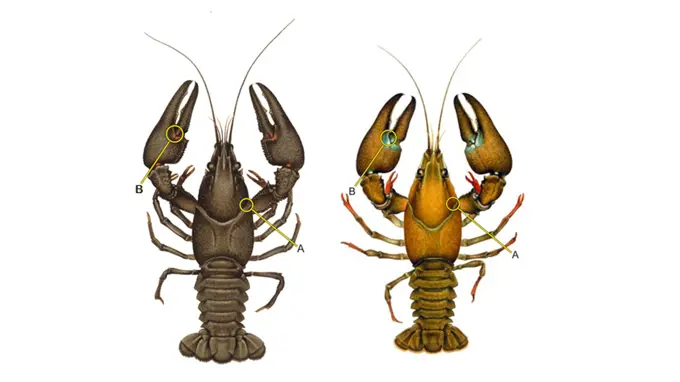Crayfish
Sweden has two freshwater crayfish species: the native noble crayfish and the introduced signal crayfish. Populations of the noble crayfish have declined dramatically in Sweden since the early 20th century, primarily due to the spread of crayfish plague.
Noble crayfish – a critically endangered species of great value
The noble crayfish (Astacus astacus) inhabits shallow waters along lake shores, in ponds and small watercourses.
It prefers steep banks where it digs deep burrows, or areas rich in roots, stones, or other hiding places. The noble crayfish is nocturnal and almost omnivorous, feeding on insect larvae, mussels, snails, fish eggs, and shoots of various aquatic plants. It can live between 5 and 20 years, with individuals up to 20 cm in length having been caught.
It is estimated that up to 97% of the Noble crayfish population has been wiped out over the past century, making it a critically endangered species. Despite this, the noble crayfish has high cultural, social, and economic value. Conservation efforts are underway across the country, focusing on cultivation and the improvement of noble crayfish fisheries.
More recently, the spread of infection from the invasive signal crayfish has accelerated this decline, along with factors such as acidification, pollution, and water regulation.

Signal crayfish – an invasive species and a disaster for the Noble crayfish
Like the crayfish, the signal crayfish (Pacifastacus leniusculus) lives in shallow lake waters, ponds, and small streams.
It too favours steep banks and hiding places with roots and stones. The signal crayfish is nocturnal and omnivorous, feeding on similar food sources. It also has a lifespan of 5 to 20 years, and can grow up to 20 cm.
Introduced in Sweden in the 1960s, the signal crayfish is a chronic carrier of crayfish plague. It has since established fishable populations in lakes Hjälmaren and Vättern, where commercial catches have increased significantly, mainly due to increased fishing effort.
Signal crayfish has provided good fishing opportunities in southern Sweden. However, its introduction has been catastrophic for the noble crayfish, with native populations declining fourfold since its arrival. As a result, the signal crayfish was officially classified as an invasive species in 2016. It is now illegal to farm or introduce the species into new waters. Introductions were banned as early as 1994, yet illegal releases have continued and remain a major issue, contributing to the continued spread of crayfish plague. Even signal crayfish can die from acute crayfish plague if stressed.

How to tell the difference between Noble and Signal crayfish
Not sure whether you’ve caught a noble crayfish or a signal crayfish? Here are four clear differences:
Noble crayfish
- A row of small spines can be felt along the border between the head and carapace (A).
- Dark, uniformly coloured claws with a dark thumb joint, often with a red wart (B).
- Long, almond-shaped claws with many warts and spiny protrusions.
- Head and carapace are dark, often blackish, with warts and spiny protrusions.
Signal crayfish
- No spines along the border between the head and carapace (A).
- Claws are often lighter underneath, with a white wart in the thumb joint, usually surrounded by a large white or turquoise patch (B).
- Claws are broad, muscular, and smoother with indented pores.
- Head and carapace are smooth with indented pores, usually in a clear brown shade.

Crayfish plague
Crayfish plague is a disease that only affects freshwater crayfish. It is a parasitic fungal infection spread via spores between individuals.
Both noble and signal crayfish can be infected, but while signal crayfish often survive and act as carriers, noble crayfish die quickly once infected.
Education and information materials
Noble crayfish and Crayfish Farming in Sweden: A Handbook Based on Experience
In 2023, SLU launched a handbook on noble crayfish farming. The handbook is in demand among farmers, authorities, and the general public, and it plays an important role in efforts to conserve the increasingly threatened Swedish noble crayfish, as well as in promoting biodiversity. It provides valuable insight into the ecology of the noble crayfish and offers detailed guidance on the conditions needed to successfully start and manage a crayfish farm.
Here you can access and download the handbook (in Swedish).
"Kräftodlingens ABC" – The Movie
In Sweden, we have good conditions for farming noble crayfish. In this video, you'll learn what is required for a successful – and profitable – noble crayfish farming operation.
More information
Read more about the noble crayfish at SLU Swedish Species Information Centre.
Read more about the Signal crayfish at SLU Swedish Species Information Centre.
Contact
-
PersonPatrik Bohman, environmental assessment analyst and deputy head of divisionInstitute of Freshwater Research
